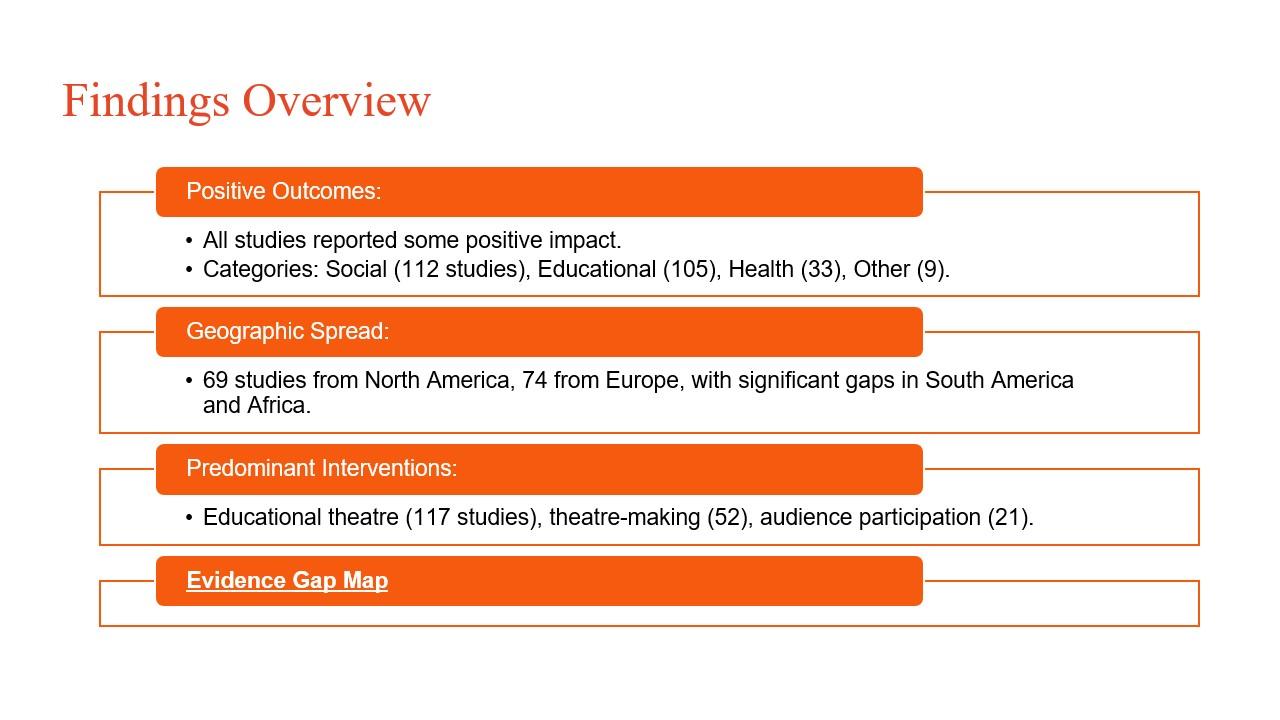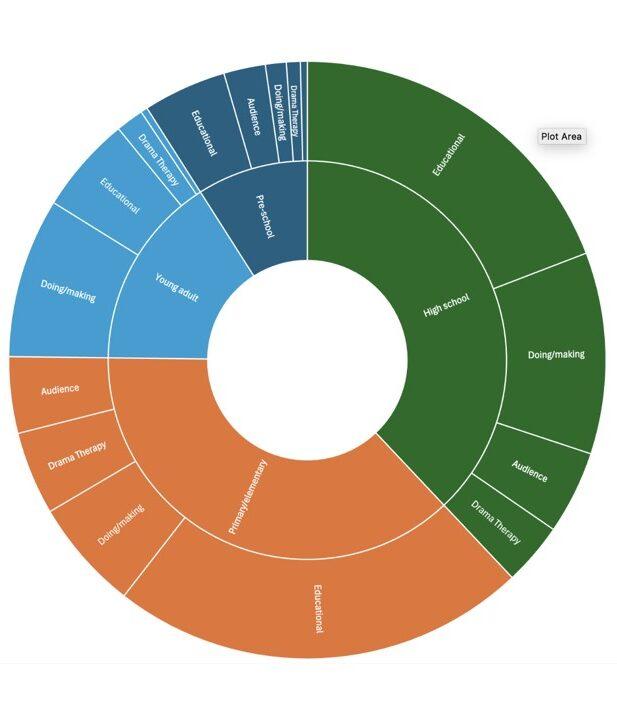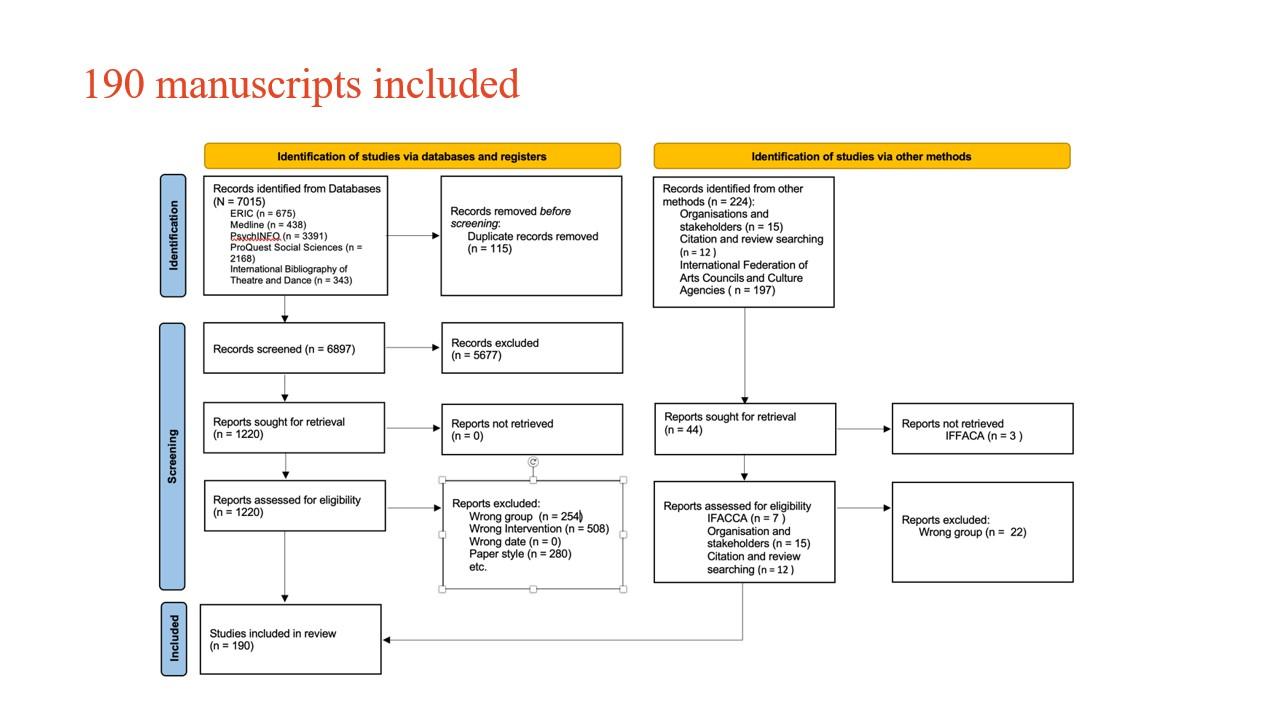This consultation report is presented as part of the Building Collective Resilience Project – Stream 5, which explores the impact of theatre on the lives of young people. This project aims to crystalise the value of theatre and performing arts engagement for young people, collating research and transforming anecdotal observations into a structured, evidence-based framework. The insights gathered seek to inform theatre and performing arts practitioners, educators, and policymakers, providing a robust foundation for future initiatives and advocacy in youth theatre and performing arts. Our approach integrates a systematic literature review and evidence gap map with insights from ‘grey literature’ and direct feedback from theatre and performing arts practitioners and participants, offering a comprehensive view of the current landscape and identifying pivotal areas for future exploration.
Broad findings
The findings from the systematic literature review indicated that evidence regarding the value of theatre and performing arts for young people oriented to four broad categories: health benefits, social benefits, educational benefits and other.

Unpacking the outcomes of the literature review – what do we know about the impact of theatre and performing arts?
Health
A minority of the valuable outcomes that were found were related to health. Health outcomes related to the following areas;
- Health education which included studies that reported health knowledge outcomes such as a deeper understanding of HIV risks or learning about healthy bodies .
- Mental health and wellbeing such as anxiety or depression ,
- General health which included all other non-psychological health outcomes , and
Social
Social outcomes made up the majority of the outcomes of the studies in the systemic literature review. Social outcomes included;
- Personal outcomes, including self-efficacy, confidence, empathy, resilience, motivation, cognitive improvements, and other individual outcomes
- Prosocial outcomes, including outcomes like community building, working together, getting along and perspective taking
- Life skills, such as understanding and reporting responsibilities and rights
- Political/social outcomes, such as activism-based changes such as writing letters to members of parliament, or knowledge/ awareness of climate change
Educational outcomes
Educational benefits were the second largest category of outcomes reported . This included:
- Curricula outcomes, included academic outcomes in non-drama topics in school such as science or mathematics
- Engagement in education, including both qualitative engagement outcomes such as enjoying school and increased attendance
- Reading/literacy/writing, which also included changes in language acquisition for second- language learners
- Theatre/drama knowledge, which included increased skills and knowledge in the field of theatre such as lighting design and script analysis
The review also aimed to assess the ages that interventions are being targeted at. Figure 2 shows the breakdown of age groups and the intervention exposures. 47 of the studies used participant samples from multiple age groups. The majority of studies involving young people and theatre involved those in primary and high school, within these age groups the outcomes reported were predominately educational and social.
Figure 1: Broad outcomes of the 190 studies reviewed

Figure 2: Breakdown of age groups in the EGM and the interventions they were exposed to

Findings on the Impact of Youth Participation in Theatre and performing arts
In addition to the comprehensive review of published and grey literature, we engaged in qualitative research with key stakeholders to examine the impact of Youth Theatre and performing arts Participation. This discussion considers the key themes that emerged from a session conducted on the impact of youth theatre and performing arts conducted at Turning Point: ASSITEJ Artistic Gathering 2023 in Novi Saad, Serbia on 23 November 2023.
The participants at the conference were from organisations who make or engage with youth theatre and performing arts from around the world. They were asked to provide feedback on “What do you see as the impact of youth theatre and performing arts?”. Participants were asked to respond in the following ways
- Generate a list collaboratively of overall themes that mapped impact and choose the top 5 and place them in order of perceived maximum impact (fig 1.2)
- Explore the themes in small groups, considering what activities, sub-themes, actions and impacts constitute each one, writing these notes on large paper; (fig 1.3)
- Display these via a gallery walk activity1, allowing other groups to add their views;
- Work together to write ‘found poems’ emerging from the gallery walk and in response to the research questions of the study;
- Perform the poems using a series of tableaus depicting how they responded to the research questions (fig 1.1)
- Consider what they know about the main research questions, and what they would like to find out.
The following is a narrative account of the session with themes identified in the subheadings and the details bolded. Where there is supporting research that has been identified through the systematic literature review references to that research are given to connect the findings from the two parts of this study.
Figure 1.1: Screen shots of tableaus taken from video of participants

Figure 1.2: Top 5 responses perceived maximum impact

Figure 1.3: Images of data collected from ASSITEJ International participants

Friendship and togetherness
Participants identified that Friendship and togetherness is fostered through theatre and performing arts participation, this is consistent with research in the field (McLauchlan & Winters, 2014). Participants findings suggest that shared experiences, emotions, and laughter create a unique meeting place in a world that can often feel disparate and confusing to young people. They reported that this sense of social connectedness is particularly valuable for young people who may be struggling with social anxieties or finding it difficult to connect with others (Fatima et al., 2017). However, participants identified that building community can be challenging for some, requiring a safe and inclusive environment where everyone feels welcomed.
Participants highlighted the inclusive nature of theatre and performing arts, especially for adolescents, allows individuals from diverse backgrounds to share experiences and build a sense of belonging, consistent with research in the area (Nelson, 2009). They describe specifically that parents and children can share common experiences through collaborative devising or performances, learning valuable social skills and the art of being together while respecting individual differences. This notion of shared experiences and togetherness in theatre and performing arts aligns with studies that emphasize the importance of social cohesion and community engagement for young people’s development (Dixon et al., 2018).
Joy
Joy is another pervasive theme, evident in the anticipation before a performance, the shared laughter during rehearsals, and the lasting memories created (Dziva & Jones, 2016). Participant responses suggest theatre and performing arts enables young people to experience joy even when grappling with negative emotions, providing a release and fostering a sense of well-being, and evidence suggests young people have improved wellbeing following theatre and performing arts participation (Alfonso-Benlliure, & Motos Teruel, 2023). Moreover, this joy of making and performing in youth theatre has been proposed to be contagious, spreading through the collaborative process and creating a sense of connection between participants, families, and the broader community (Dziva & Jones, 2016). The act of performing itself was highlighted as a way to spark a unique joy in the body, fostering empathy through kinaesthetic experiences (understanding through physical movement).
Play, curiosity and creativity
Participants highlighted that theatre and performing arts can engage young people in play, curiosity, and creativity. Specifically, working in processes of devising and through scripted drama allows the discovery of new worlds and cultures, enabling exploration beyond participant’s everyday lives. This exploration is proposed to fuel imagination, allowing them to envision possible futures and even experience physical transformation through movement and body language. For participants, Theatre and performing arts provides a platform for experimentation and self-discovery, encouraging young people to engage with the unknown and create new versions of different art forms.
Learning
Theatre and performing arts was discussed to offer a unique space for learning that extends beyond traditional classroom settings, which has been well documented in research. Participants suggested that the immersive and participatory nature of theatre and performing arts encourages focused attention and provides motivation for learning new skills and concepts. Evidence suggests that through kinesthetic empathy, young people can learn by moving and responding to emotions and stories, actively recreating and adapting performances (O’Grady, 2020; Wright et al., 2019). This process has been shown to potentially reverse roles, with children teaching adults new perspectives and fostering a safe space for emotional engagement and physical exploration (breaking boundaries) (Wright et al., 2019). Therefore learning through theatre and performing arts goes beyond factual knowledge, fostering critical thinking, understanding context, and asking thought- provoking questions.
Empowerment
Participants emphasised that theatre and performing arts empowers young people by fostering a sense of honesty and respect within an ensemble through collaboration. Their work suggests that recognizing similarities with diverse characters and seeing themselves represented on stage can be transformative, allowing them to identify their own potential and possibilities. This sense of empowerment appears to extend beyond the stage as young people learn to share ideas, collaborate with others, and advocate for themselves. The process of co-creating and performing potentially allows them to build creative confidence and find validation for their unique perspectives, even in the midst of potential challenges in their personal and social worlds.
Concluding reflections
This report not only highlights the value of theatre and performing arts in fostering a sense of community and self-expression among youth but also highlights critical gaps in current research. Our analysis of the qualitative data compared to our findings in the systematic review suggests that practitioners hold strong shared beliefs about the impact of theatre and performing arts for young people, but that these are not often the focus of empirical research. Areas such as joy and happiness, future-thinking and planning, and creativity were all strong themes in the qualitative data but marginal or absent in the published literature. Further research could build evidence in areas that align with the interests and beliefs of practitioners which could have guide the development of policy and practice in the sector.
The evidence gap map established several areas with less substantial or accessible research finding including:
- Data from specific geographical regions (particularly South America, Africa, and Eastern Europe)
- Data about certain types of participation (going to the theatre, drama therapy, and making theatre)
- Data with outcomes in health or mental health.
These gaps do not necessarily represent actual gaps in research undertaken, but rather illustrate the difficulties in accessing research from certain areas or indicate a lack of research interest or expertise from certain sectors. While a more extensive search was not in scope for this project, further research could build on the current systemic literature review and evidence gap map to target specific research and draw out a more comprehensive and nuanced understanding of the impact of theatre and performing arts for young people.
The Building Collective Resilience Project – Stream 5 has significantly advanced our understanding of the role theatre and performing arts plays in nurturing the wellbeing and social and educational development of young people. The findings underscore the multifaceted benefits of theatre and performing arts, spanning educational, social, and personal growth. It is imperative that stakeholders in the arts and education sectors consider these insights to enhance the accessibility and impact of theatre and performing arts programs. The collaborative nature of this project and the engagement with diverse perspectives reinforce the essential role of inclusive, community-driven, sector- appropriate and participant-led approaches in expanding the reach and depth of theatre’s positive outcomes. Moving forward, it will be crucial to build on these foundations, development an evidence-based investment in and commitment to youth theatre and performing arts as a vital educational and cultural tool.
Aims and methods
This project stems from a belief that engaging in theatre is a valuable experience for young people. The aim of the study is to build on this belief to establish a more nuanced and evidence-informed understanding of what that value is. To do so, this study is asking two overarching questions:
- How does engagement with theatre impact the lives of young people? And
- how do we know?
The work aims to provide theatre makers, teachers, scholars, funders, project managers, and administrators with organised and clear information about the value of theatre and performing arts for young people to assist in planning and evaluation of programs and to advocate and argue for the importance of their work.
There are three key components of this project:
- Systematic literature review and evidence gap map of published academic literature: On June 6, 2023, a comprehensive literature search was completed. Academic databases were searched for three concepts: (a) Theatre and (b) young people and (c) value. Based on predetermined inclusion and exclusion criteria, studies were then included for further review and coding into the evidence gap map. Data was coded based on the following: (1) study region; (2) publication language; (3) study design; (4) age group of participants; (5) intervention; (6) outcomes; and (7) limitations/challenges. The results of this are on the next page.
- Inclusion of ‘grey’ unpublished literature such as reports commissioned by theatre and performing arts companies, websites, policy documents, or literature published in magazines in the systematic review and evidence gap map: we are now using what we’ve found from the review of published literature to target and collect literature from areas where there are gaps in our knowledge – whether that’s a geographic area, intervention type or outcome and to collect literature directly from TYA practitioners and companies.
- Responses from TYA practitioners and participants to understand more deeply their experiences and why and how they feel theatre and performing arts is valuable.


Regions
190 studies were included. They were included were conducted across six regions: Asia (21), North America (69), Oceania (21), South America (4), Africa (5) and Europe (74). Three studies took place over more than one region.
Interventions/programs that have been evaluated
117 of studies included educational drama/theatre, 21 reported on going to the theatre/being an audience member, 52 included young people doing or making theatre, 15 of study interventions were therapeutic such as drama therapy or psychodrama, and 3 had other theatre interventions. Several studies utilised more than one type of intervention, such as a theatre workshop that included going to a play.


Authors
Kelly Freebody
Michael Anderson
Eliza Oliver
The CREATE Centre
We recognise and pay respect to the Elders and communities – past, present, and emerging – of the lands that the University of Sydney’s campuses stand on. For thousands of years they have shared and exchanged knowledges across innumerable generations for the benefit of all.

Professor Kelly Freebody
kelly.freebody@sydney.edu.au
Eliza Oliver
eliza.oliver@sydney.edu.au
Professor Michael Anderson
michael.anderson@sydney.edu.au
References
Alfonso-Benlliure, V., & Motos Teruel, T. (2023). To perform or not to perform, that is the question: Drama activities and psychological wellbeing in adolescence. Applied Theatre Research, 11(2), 155- 173.
ATYP. (2023, March 17). Research reveals positive impact of youth theatre on young Australians [Press release]. Retrieved from https://atyp.com.au/research-reveals-positive-impact-of-youth- theatre-on-young-australians/
Dixon, J., Durrheim, K., Tredoux, C., & Tropp, L. (2018). Intergroup contact and the social psychology of youth civic engagement. Child Development Perspectives, 12(3), 177-182.
Landy, R. J. (2010). Drama as a means of preventing post-traumatic stress following trauma within
Fatima, M., Niazi, S., & Ghayas, S. (2017). Relationship between self-esteem and social anxiety: Role of social connectedness as a mediator. Pakistan journal of social and clinical psychology, 15(2), 12- 17.
McLauchlan, D., & Winters, K. L. (2014). What’s so great about drama class? Year I secondary students have their say. Research in Drama Education: The Journal of Applied Theatre and Performance, 19(1), 51-63.
Nelson, B. (2009). Beyond belonging: The relationship between community and power for urban students of color. Drama Research: International Journal of Drama in Education, 1, 60-74.
O’Grady, A. (2020). Pedagogy, Empathy and Praxis: Using Theatrical Traditions to Teach. Cham: Palgrave Macmillan
Wright, R., Wright, C., & Peltier, A. (2019). The transformative potential of performing arts education: Building learning communities. International Journal of Education & the Arts, 20(5).



Co-funded by the European Union and the Danish Arts Foundation. Views and opinions expressed are however those of the author(s) only, and do not necessarily reflect those of the European Union or the Danish Arts Foundation. Neither the European Union or the Danish Arts Foundation can be held responsible for them.


